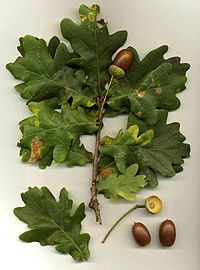
Photo from wikipedia
PREMISE Water deficit and drought conditions are increasing in intensity, frequency, and duration in the Iberian Peninsula. We observed natural variation in leaf traits across the range of Quercus suber… Click to show full abstract
PREMISE Water deficit and drought conditions are increasing in intensity, frequency, and duration in the Iberian Peninsula. We observed natural variation in leaf traits across the range of Quercus suber L. (cork oak), an ecologically important species within this region. Stomatal traits (e.g., pore length, maximum aperture) and carbon isotope composition (δ13 C) provide an opportunity to examine the integrative effects of drought and dry-season intensity on leaf development, maximum stomatal conductance, and adaptation to precipitation regimes. METHODS Gross leaf traits (e.g., area, thickness), stomatal traits (e.g., pore length, size, aperture), and carbon isotope discrimination were measured in Q. suber leaves, and maximum stomatal conductance to water vapor (gwmax ) was calculated. Trees were sampled from nine natural populations across a climate gradient in the Iberian Peninsula, including trees from two genetic lineages. Linear mixed models compared total water deficit to leaf traits, accounting for tree and site as random effects. RESULTS Quercus suber gross leaf morphology remained consistent across the climate gradient, but increasing water deficit was correlated with smaller stomata at the leaf level and low δ13 C at the tree level. No traits were significantly different between the two genetic lineages. CONCLUSIONS While there were no significant differences in gross leaf morphology across the climate gradient or between the genetic lineages, stomatal traits and δ13 C responded to climate, suggesting that Q. suber can inhabit a range of environments in the Iberian Peninsula via micro-adjustments of the trait that controls water loss into the atmosphere.
Journal Title: American journal of botany
Year Published: 2019
Link to full text (if available)
Share on Social Media: Sign Up to like & get
recommendations!